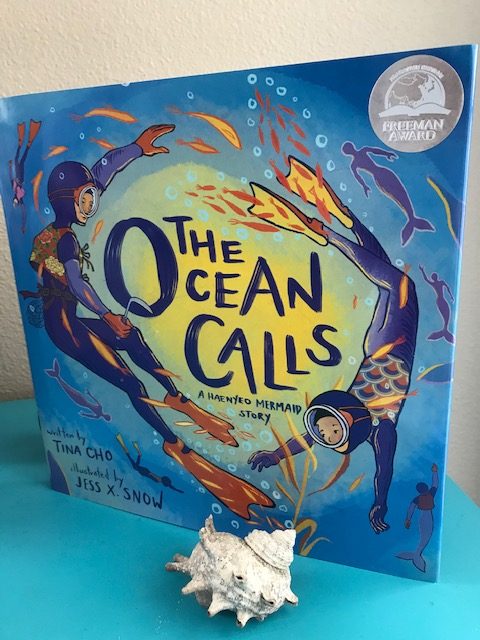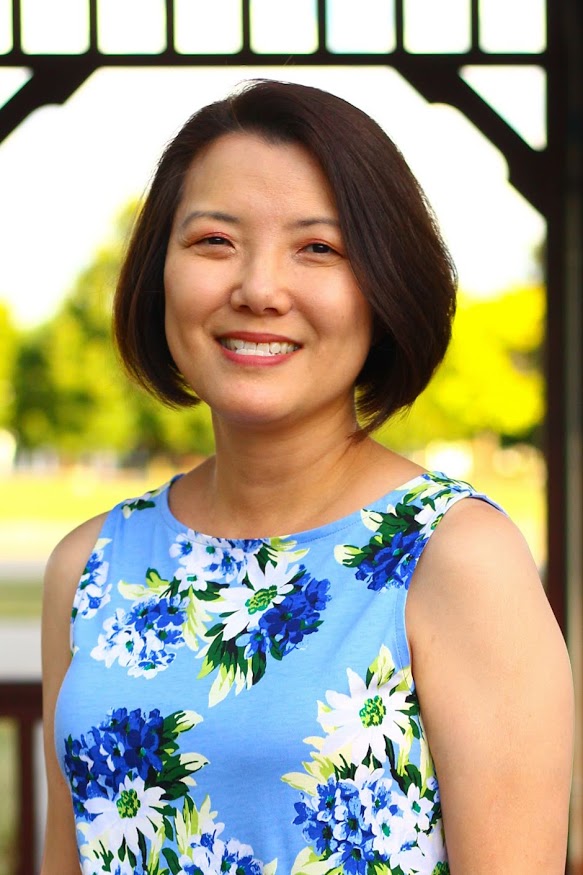Tina Cho is the author of four picture books, including The Ocean Calls: A Haenyeo Mermaid Story (illustrated by Jess X. Snow), which was released in August 2020. She is interviewed here by APALA member Molly Higgins.
Molly Higgins (MH): Please introduce yourself and briefly describe your literary work and career path to date.
Tina Cho (TC): I’m honored to be on your blog! Thank you for featuring my latest picture book, The Ocean Calls, a Haenyeo Mermaid Story, for review as well. After living in South Korea for the past ten years, my family moved to Iowa last summer. I’ve been an elementary teacher for 17 years and am currently a kindergarten online teacher due to the pandemic.
In 2008, I decided to try writing for children since as a teacher I loved picture books. I joined SCBWI (Society of Children’s Book Writers & Illustrators), an in-person writing group, took picture book writing classes online, and joined online writing critique groups.
My early writing was mainly for the educational market, writing lesson plans and guided reading books as well as for a children’s magazine, Clubhouse Jr. Living in Korea opened my world to new ideas in which there weren’t many picture books. All four of my picture books and my forthcoming middle grade graphic novel feature Korean themes. I love finding nuggets of information and want to share it with children around the world, especially American kids.
MH: At the end of The Ocean Calls, you include some information about the haenyeo tradition. For people who are reading this interview, and are unfamiliar with the tradition, can you tell us a little about it here?
TC: Off the coast of Jeju and the southern tip of mainland Korea, haenyeo, women divers, dive into the ocean without any breathing equipment and catch creatures to cook and sell. Most of these women are between 50 and 90 years old. They learned the tradition from their mothers. The haenyeo tradition goes back centuries. In 2016, UNESCO inscribed the haenyeo life on their list of Intangible Cultural Heritage of Humanity. When I first heard about these women, I was amazed at their strength and agility.

MH: You use the terms haenyeo and jamnyeo, the first coming from Japanese and the second coming from Korean. Can you tell me about the difference between the two terms? Is haenyeo the preferred term?
TC: Jamnyeo is an old Korean term used before the Japanese occupation of Korea (1910-1945). Haenyeo is the Japanese word that was used during the Japanese occupation and is still most commonly used. (During the occupation, Japanese forced Koreans to change their names and speak Japanese.)
MH: You grew up in the U.S., and currently live in Korea (Editor’s note: Cho now lives in the states). Do you think your personal identity influenced the way you told this story?
TC: Yes, I believe my personal identity influenced the way I told this story. Koreans have known about haenyeo for centuries. So why are there hardly any Korean children’s books about them? Many Koreans and some haenyeo looked down on this way of life. First, back in the day, it wasn’t becoming to be a haenyeo. Before they wore the black wetsuits, they dove in cotton clothing that was deemed immodest. Second, these women weren’t as educated as women who could study on the mainland. Third, their way of life was quite dangerous and risky each time they dove into the ocean. Who would want this for their own daughters? And lastly, the women dealt with health problems from diving into the sea. But as an outsider, I saw the haenyeo with a different perspective—strong elderly women with intergenerational relationships, knowledgeable of the sea, proactive working women who cared for their families.
MH: Did you think about writing this book for a specific audience, and how did that affect the way you told this story?
TC: The audience I had in mind was children, of course. Because I have a great relationship with my own grandmother, I wanted to showcase that intergenerational relationship between a haenyeo and her granddaughter. Even though this tradition is dying off in some Korean families, this way of life is still ongoing for others. I want children, even American children, to see that they can learn a tradition from their own grandparents or elderly. So that’s why I chose to write this as a fiction picture book, but in the back matter, include facts about the haenyeo.
MH: We’re always looking for more to read. Who are five authors we should be reading? Why?
TC:
- Joanna Ho, author of the renowned picture book, Eyes That Kiss in the Corners. She is of Taiwanese and Chinese descent, who champions for racial justice in her books. I’m amazed she has time to write because she’s also a high school vice principal and mother of two young children!
- Linda Sue Park, Newbery Award-winning writer, has cultural themes throughout her books, a champion for anti-racism, and her latest novel, Prairie Lotus, spoke to my heart about racism in America. Linda Sue also started Kibooka, in which I’m a part of, a group of Korean American authors and illustrators.
- Frances and Ginger Park, Korean American sisters of North Korean descent who write children’s books and adult books. Their North Korean mother left them with a rich cultural heritage and plenty of stories from her past in which they are able to share Korea’s divided history. They also own a chocolate shop in D.C.
- Christina Soontornvat, a Thai American, has won so many awards, most recently, the Newbery Medal Honor twice. I recently read A Wish in the Dark. Children can learn about Asian culture through her writings.
- Jessica Kim, a debut Korean American middle grade writer wrote Stand Up, Yumi Chung. Jessica shares Korean culture to middle grade kids in fun ways.
MH: You’re being interviewed by a librarian, for an audience of progressive Asian Pacific American librarians. What are your thoughts on libraries and their place in building diverse communities?
TC: I love libraries, grew up in them in a sense and took my own kids when they were little to library programs. As a teacher, I’m constantly visiting my school library. I get to know the librarians! Currently, I think it’s wonderful that libraries are updating and being more selective in the books they purchase to offer more diverse reading selections to families. In my opinion, I think if children could read books about characters from all over, they would not be so surprised when they encounter another person who doesn’t look like them. I also think if families knew that their local library carried books on their culture or even in their language, they would visit more often.
MH: What advice would you give young professionals, especially those from diverse backgrounds, who are interested in a career in writing?
TC: Jump into writing, NOW! Seriously, editors are wanting stories from “own voices.” They want diverse books to help stop the racial divide of America. All those experiences from one’s past could provide rich cultural stories for the next generation. Things from your culture that you view as mundane, trivial things could turn into meaningful ideas for children’s books. There are many children’s writing classes and a wonderful writing organization that I mentioned before, SCBWI.
MH: The art in this book is so beautiful. I love the way that Jess X. Snow incorporates mermaids into the shadows and background. How did your collaboration come about?
TC: As is the case in most American children’s publishing, the author doesn’t get to choose the illustrator. Jasmin Rubero, my publisher’s art director, found Jess X. Snow. I love her beautiful illustrations and scenery. Jess added a whole new layer to my story of magical realism. Because my book was based on a specific place and group, I’m thankful my editor and art director did share Jess’s drawings along the way for my feedback. Jess wasn’t able to fly to Jeju, but I had been there twice. I also shared my photos with my editor who passed them along to Jess. I didn’t meet Jess until after our book was published. We did a Zoom book launch together with a bookstore in Georgia.
MH: Is there anything else you’d like us to know?
TC: The Ocean Calls is an honorable mention for The Freeman Book Award. It also garnered four stars (Kirkus, School Library Journal, Booklist, and Publishers Weekly). It’s available as an audiobook from Penguin Random House. More good news for this book is coming soon!
“The National Consortium for Teaching about Asia (NCTA), the Committee on Teaching about Asia (CTA) of the Association for Asian Studies (AAS), and Asia for Educators (AFE) at Columbia University sponsor the annual Freeman Book Awards for new young adult and children’s literature. The awards recognize quality books for children and young adults that contribute meaningfully to an understanding of East and Southeast Asia. Awards are given in two categories: Children’s and Young Adult on the several countries of East and Southeast Asia.”
Source: https://nctasia.org/freeman-book-awards/
Instagram: @TinaMCho
Twitter: @TinaMCho
Website: http://www.tinamcho.com
Editing assistance by Amanda M. Cheung.

